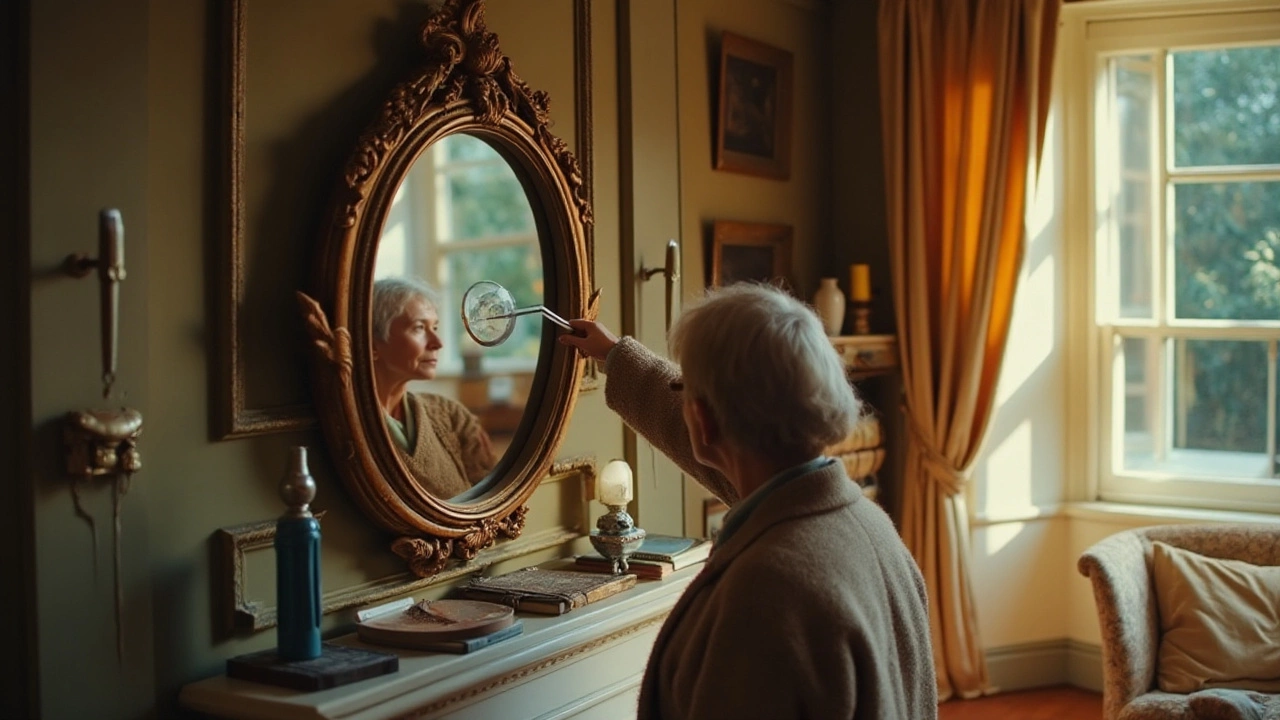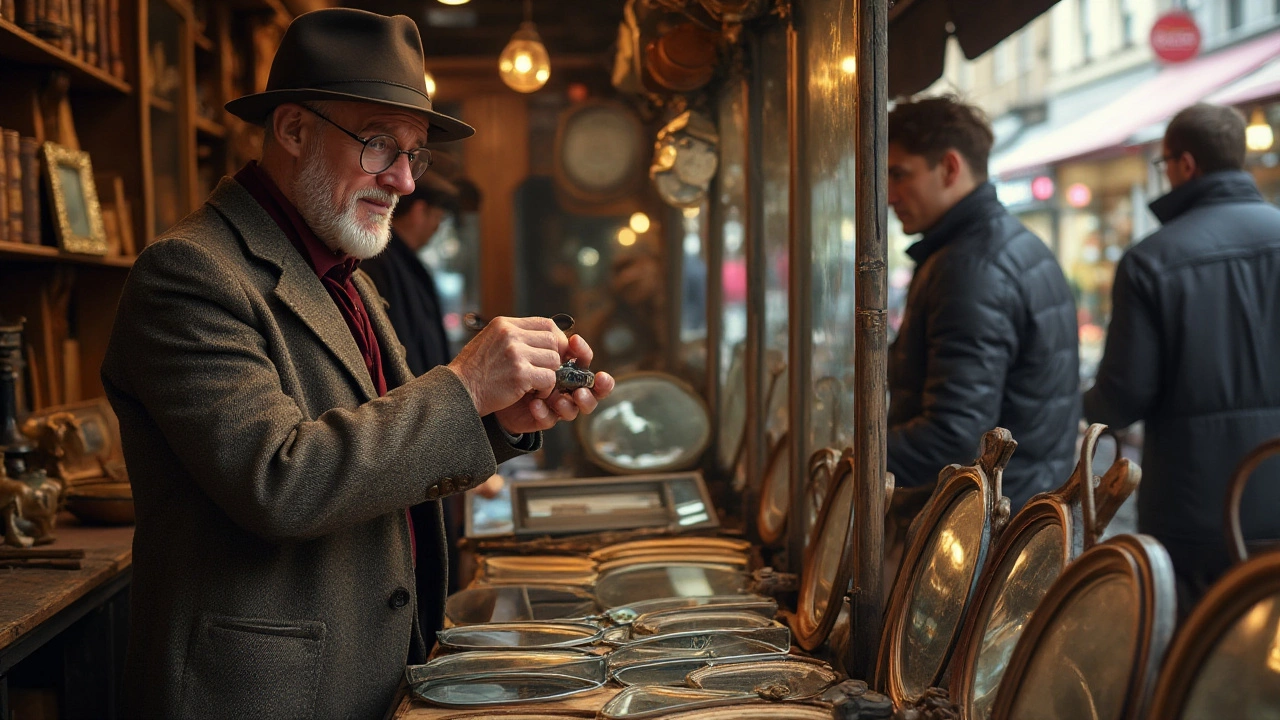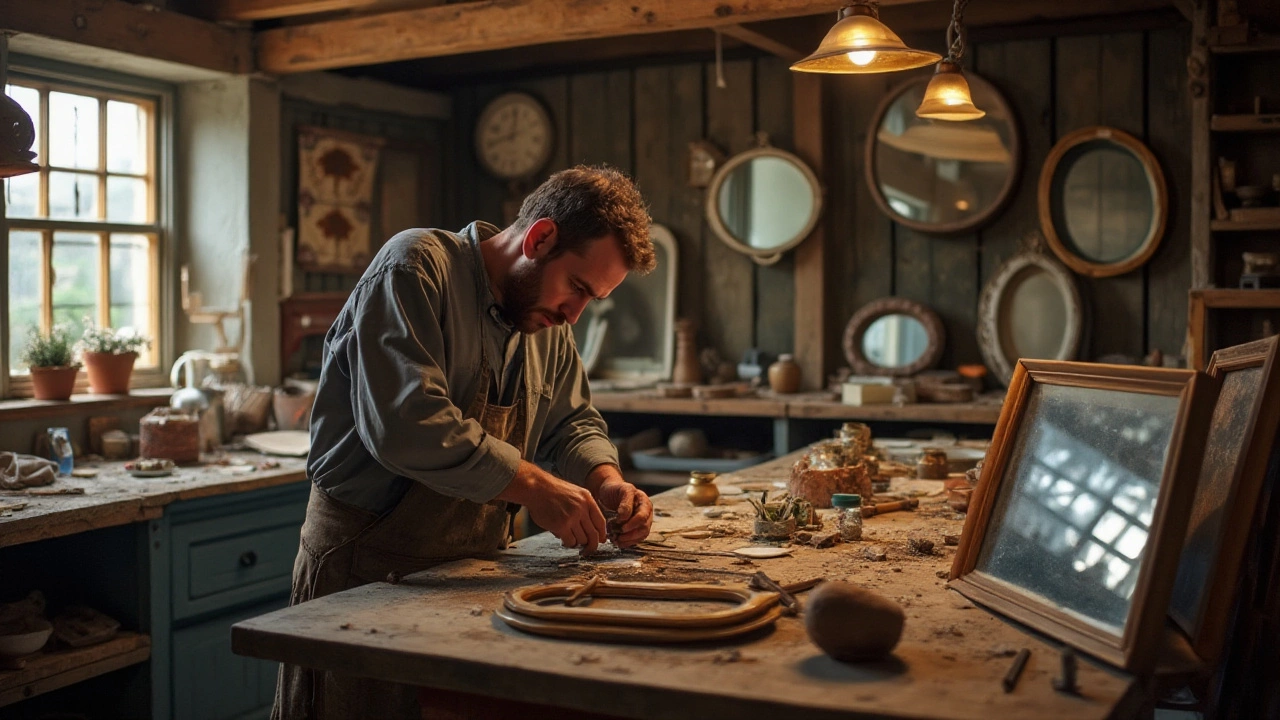Detecting Authentic Mirrors: Tips and Tricks
 Jan, 13 2025
Jan, 13 2025
Mirrors are fascinating objects. They've been around for centuries, reflecting not just images but a bit of history and mystery too. So, how do we know if a mirror is the real deal? In this article, we will unravel the secrets of mirror authenticity, sharing practical tips to help you spot a genuine one.
From quick tests you can do at home to intriguing historical tidbits, there's a lot more to these shiny surfaces than meets the eye. Whether you're a curious soul or simply someone looking to buy a new mirror, this piece promises to illuminate your understanding.
- The Science Behind Mirrors
- Physical Characteristics of Real Mirrors
- Simple Tests for Authenticity
- Historical Insights
- Caring for Your Mirror
The Science Behind Mirrors
Have you ever gazed into a mirror and wondered how it could perfectly replicate your image? The answer lies in the fascinating sphere of optics, where the behavior of light plays a starring role. At their core, mirrors function as objects that reflect light in such a precise manner that the human eye sees the reversed image on its surface. This seemingly magical property is achieved through a flat, highly polished surface, typically made of glass, coated with a thin layer of silver or aluminum on the back to make it reflective. When light hits the mirror, it doesn't scatter; instead, it bounces back in a straight line, maintaining the characteristics of the image, including color and detail.
Understanding the science involves diving into the laws of reflection. The law, which is simple yet powerful, states that the angle at which light strikes a surface (incidence angle) is equal to the angle at which it reflects off (reflection angle). This predictable behavior is what allows mirrors to create clear and sharp reflections. One crucial aspect of real mirrors is that they are made from quality glass, which ensures minimal distortion. The use of high-grade materials distinguishes a real mirror from a cheap imitation, which often results in warped reflections due to inferior materials.
The historical journey of mirrors is equally intriguing. Early versions made from polished stones date back thousands of years, while today's mirrors have evolved significantly with advances in technology. Modern mirrors are often created using a process called 'silvering', where a thin metallic layer is laid onto the back of glass. But did you know that the concept of mirrors has even permeated scientific literature? In the words of renowned physicist Richard Feynman, "All the light that we can see, and even the light we cannot see, reflects and refracts in accordance with the same basic principles."
Citation pitstop: "Reflection occurs at all levels of physics, and mirrors are a timeless medium to intrigue and delight," says Professor Lucas Whelan, an expert in optical physics at The University of Cambridge.
The Role of Coatings
Delving deeper, the coatings applied to mirrors are crucial as they enhance reflectivity and durability. Silver was traditionally favored, but aluminum is now popular because of its excellent reflectance across the visible spectrum. The thickness of these coatings often varies, fine-tuned to adapt to specific applications, from telescopes to vanity mirrors. Sometimes, protective coatings are added on top of the metallic layer to prevent tarnishing and scratching, ensuring longevity. It's not just about bouncing back light; it's about preserving the quality of reflections over time.
Now, if science fiction has taught us anything, it's that mirrors are more than reflective surfaces; they're gateways, sometimes literally, to other realms of technological wonder. A fascinating application is in adaptive optics used in astronomy, where mirrors adjust to counteract atmospheric distortion, leading to sharper, clearer images of the night sky. This innovative use showcases the potential of mirrors beyond just reflection, pointing to a future where our understanding of optics may indeed open new doors—or mirrors, so to speak.
Physical Characteristics of Real Mirrors
When it comes to determining the authenticity of a mirror, understanding the physical characteristics that set real glass mirrors apart from their imitated counterparts is crucial. Most genuine mirrors are made by coating a flat piece of glass with a thin layer of silver or aluminum. This metallic backing provides the reflective quality every mirror boasts. A key characteristic to look for in real mirrors is the clarity of reflection. Real mirrors, thanks to their precise manufacturing process, offer an impeccable and sharp reflection. An imitation mirror might give a distorted or slightly warped image, which is a dead giveaway of its make.
Another aspect to consider is the thickness of the mirror. Authentic glass mirrors tend to be thicker and weightier compare to fake ones made from lower quality materials like acrylic or polystyrene. Though light weight imitations might seem advantageous for some uses, they don’t provide the durability or the quality that’s expected from genuine mirrors. Holding a mirror and feeling its heft can often give you a first impression of its authenticity which is hard to misjudge. It's also worth noting that the edges of the glass should be smooth and well-finished, indicating superior craftsmanship.
Inspecting the backing of a mirror can also reveal a lot about its make. Typically, the metallic coating should appear consistent and free of any blemishes or spotting. Discoloration or any visible separation from the glass can point to a fake or poorly manufactured mirror. As Roger Warren, a renowned glassmaker once said, "A mirror is only as authentic as its reflection is precise."
Mirrors are a perfect blend of art and science, each reflecting the diligence of craftsmen who refine them to reflect only the truth they face.Besides, the backing should be seamless and well-sealed to prevent moisture penetration, something common in sub-standard products which ends up degrading the mirror over time.
Though it might appear cosmetic, real mirrors often offer high quality framing which complements their reflective surface. The frame not only enhances the mirror's aesthetic value but also protects its edges. Be wary of flimsy frames which sometimes accompany fake mirrors. In some cases, the edges might have a beveling – a stylish angled finish that reduces the glass's apparent thickness while giving it a sleek look. It's a feature often seen on authentic mirrors intended for upscale use. By examining these physical attributes, both subtle and distinct, you’ll be better equipped to determine the authenticity of a mirror. Looking for these signs can always ensure you are investing in a product that will last and beautifully reflect its surroundings.
To consolidate all this information into a more comprehensible format, here's a quick overview of key physical characteristics to look for in real mirrors:
- Clarity of reflection
- Thickness and weight of the glass
- Consistent backing quality
- Superior frame finish
- Well-crafted edges, possibly with beveling
Understanding these characteristics not only helps in identifying genuine mirrors themselves, but also brings to light the meticulous details involved in their creation. Each aspect reflects a standard of quality that continues to define authentic mirrors in the face of evolving manufacturing technology. Dive deeper into these details the next time you encounter a mirror, and see how many checks can be ticked off your list!

Simple Tests for Authenticity
Determining whether a real mirror is genuinely reflecting or merely pretending can be an intriguing endeavor. Many of these simple tests can be accomplished using everyday items in your home, revealing the secret behind those glassy surfaces. One tried-and-true technique is the 'fingernail test'. Place your fingernail against the mirror's surface and look for the gap between your nail and its reflection. A real mirror, made with a silver backing, should show a tiny gap. No gap, and you might be dealing with a two-way mirror, often utilized in security and surveillance settings. This test harnesses the science behind reflections where light bounces off the mirror's backing layer and returns to present the image.
Another curious test involves employing a flashlight. Shine it directly onto the mirror, and observe carefully whether the glass disperses the light. A false mirror or an imperfectly manufactured one will show distinct light scatter. True mirrors, crafted to precision, display a clear and focused beam as the glass surface handles light consistently. The paper test is another handy trick; place a white piece of paper against the mirror and note if the paper remains brilliantly white. The presence of any unwanted tints suggests inferior manufacturing or materials involved, pointing towards potential imitation.
The weight test may not be quantifiable in numbers but offers insight. Traditional, silvery-backed mirrors tend to be heavier due to the materials used. Hold the mirror in your hands and feel the weightiness. Compare two similar-sized mirrors—one might feel substantive while another surprisingly light, possibly indicating lower-quality plastics or acrylics in poor imitations.
If you're still uncertain, tap gently on the surface. The sound can be revealing; real glass mirrors produce a resonant, solid tone. False mirrors, often the product of acrylic or plastic, emit more of a dull thud due to differences in density and structure. These tests are easily executed without special tools, providing immediate results.
For those deeply interested in authenticity, a thermal test could be considered as well. Hold your palm against the mirror and observe closely. Genuine glass and silver mirrors slowly warm up, holding heat briefly due to the thermodynamic qualities of glass and metal. Across generations and regions, people have trusted these tests to discern true from false reflections.
Historical Insights
The history of mirrors is as reflective as the objects themselves, tracing back thousands of years. Early civilizations used polished stones, like obsidian, to catch glimpses of their reflections. Such practices date back to around 6000 BC in Anatolia (modern-day Turkey), where these volcanic glasses were among the first known mirrors used by humans. As technology and societies advanced, so did the materials and techniques in crafting mirrors. Egyptians were known for crafting mirrors from polished copper around 2900 BC, cherished for both their utility and their beauty.
From Antiquity to the Middle Ages
Mirrors took on greater significance in Roman and Greek cultures, where they incorporated silver and bronze. These materials allowed for more refined reflections, which were popular among the elite. The cultural role of mirrors extended beyond mere vanity; they were often imbued with mystical and philosophical symbolism. Buddhist texts, for instance, utilized mirror reflections as metaphors for introspection and enlightenment. Fast forward to the Middle Ages, and we see mirrors being handcrafted by skilled artisans in workshops in Venice. These Venetian mirrors, made with a mercury coating, were the pinnacle of craftsmanship and remained luxurious items only the wealthiest could afford.The Evolution of Mirror Crafting
During the Renaissance, mirror-making saw significant innovations. In 1835, it was a German chemist, Justus von Liebig, who discovered a method to deposit a thin layer of metallic silver onto glass, revolutionizing how real mirrors were made. This process was not just a game-changer industrially but also democratically, as it made mirrors more accessible to the general public. Prior to this discovery, mirrors were rare and expensive, often considered artworks or family heirlooms.The twentieth century saw the advent of mass production, reducing costs and making mirrors an integral part of daily life. Now, mirrors are ubiquitous, yet we often take for granted the curiosity and innovation they embody. The story of mirrors continues as new technologies emerge, infusing them with smart functionalities. From obsidian reflections to real mirror glass, our fascination has only deepened over the millennia.
Quirky Facts and Cultural Tidbits
Mirrors hold an intriguing grip on culture and folklore. Romans believed breaking a mirror would curse the victim with seven years of bad luck, a superstition that persists today. Ancient Chinese feng shui practices involve strategic mirror placements to direct or improve energy flow within a space. Today, mirrors remain embedded in our psyches not just as tools, but as symbols of self-reflection and seeing beyond the surface. As we peer into a mirror, perhaps it's worth remembering the journey these everyday objects have traveled, from the hands of ancient artisans to the gleaming sheets of glass that now grace our homes.
Caring for Your Mirror
Caring for your mirror involves more than the occasional swipe with a cloth. For a true mirror authenticity to shine, routine maintenance and care are key. This attention to detail keeps your mirrors not only functional but also a beautiful element of decor. Begin by avoiding direct sunlight, which can cause the backing of the mirror to fade or even crack over time. The constant exposure to heat isn't a friend to these intricate surfaces. Instead, position mirrors away from windows or anywhere the sun might unmercifully beat down on them. Temperature changes can also play a significant role, so try to maintain a stable environment for them as much as possible, where abrupt changes in the room’s temperature are minimized.
Cleaning your mirrors plays a pivotal role too. It’s crucial to use the right cleaning agents—or lack thereof. Stick with dampened microfiber cloths, as they are gentle yet effective. Steer clear of commercial cleaners that contain harsh chemicals. Such products can erode the coating over time, leaving you with a pitted, worn-out reflection. A simple mix of water and vinegar usually does the trick for most cleaning needs. For a clear reflection free from streaks, gently buff in circular motions. Additionally, keep water away from the edges of the mirror; as water seeps into the edges, it causes the silver backing to tarnish. This process is known as “black edge’ and is irreversible, which is precisely why preventive care is essential.
Protection from physical damage is another component. Mirrors might seem sturdy, but they are incredibly delicate. When relocating or rehanging them, always opt for professional assistance to avoid any accidental damage. If doing it yourself, make sure you use appropriate hanging hardware designed specifically for mirrors. This ensures both their safety and yours, preventing any chance of them slipping off the wall. Mirrors housed in high-traffic areas are especially vulnerable to accidental bumps, so always remind those at home of their fragility.
"A mirror can fracture with the shift of seasons, much like the human spirit. Protect both with kindness." - Anonymous
The lifespan and clarity of a mirror are also directly impacted by its frame or housing. Regularly check frames for signs of wear or warping, particularly in areas of high humidity like bathrooms. With wooden frames, make sure the joints remain snug, as expanding and contracting wood can disturb the mirror glass, leading to a warped reflection. Metal frames require checks for corrosion or rust, which can spread to the reflective surface of the mirror itself.
Finally, consider the space in which the mirror is displayed. Rooms with high humidity, like bathrooms, should have adequate ventilation to prevent condensation on mirror surfaces. Since moisture is the enemy, running a dehumidifier or simply allowing airflow through open windows can significantly lessen chances of damage. Pay attention to the placement as mirrors should remain functional yet decorative. The strategic angling of a mirror can amplify a room's light or give an illusion of space.
By following these insights, you'll ensure that each real mirror continues to reflect not just your visage, but also the care you invest in maintaining its allure.